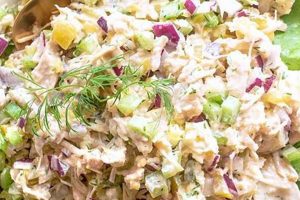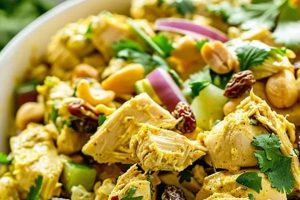This dish typically features shredded or diced chicken, combined with various ingredients like potatoes, carrots, celery, onions, and sometimes raisins or apples. A creamy dressing, often mayonnaise-based with sweet pickle relish, binds the ingredients together. Variations exist, incorporating ingredients such as pineapple, cheese, or hard-boiled eggs, showcasing regional and personal preferences.
This savory and refreshing salad holds a significant place in Filipino cuisine. It’s commonly served during festive gatherings, holidays, and special occasions. The adaptability of the recipe allows for both simple and elaborate versions, catering to various budgets and tastes. Its popularity stems from the blend of familiar flavors and textures, creating a comforting and satisfying dish. The dish’s relatively simple preparation also contributes to its widespread appeal.
Exploring the nuances of this culinary creation unveils a deeper understanding of Filipino culinary traditions. From ingredient selection to preparation methods, the following sections will delve into the heart of this iconic dish, offering practical guidance and insights.
Tips for a Delicious Chicken Salad
Achieving a well-balanced and flavorful chicken salad requires attention to detail. These tips offer guidance for optimal results.
Tip 1: Chicken Selection: Opting for poached or roasted chicken breasts yields a superior flavor profile compared to pre-cooked or canned options. The poaching or roasting process allows for greater control over seasoning and moisture content.
Tip 2: Vegetable Preparation: Uniformly dicing vegetables ensures even distribution of flavor and texture throughout the salad. Slightly blanching vegetables like carrots and potatoes can enhance their tenderness.
Tip 3: Dressing Consistency: The dressing should be creamy and well-emulsified. Adjusting the amount of mayonnaise or adding a touch of milk or cream can achieve desired consistency.
Tip 4: Balancing Sweet and Savory Elements: The interplay of sweet and savory components defines this dish. Adjusting the quantity of sweet pickle relish, raisins, or other sweet ingredients allows for customization of the flavor profile.
Tip 5: Chilling Time: Allowing the salad to chill for at least an hour before serving enhances the melding of flavors and allows the ingredients to marinate in the dressing.
Tip 6: Ingredient Variations: While traditional recipes offer a solid foundation, exploring variations with ingredients like pineapple, apples, grapes, or cheese can create unique and exciting flavor combinations.
Tip 7: Serving Suggestions: This versatile salad can be enjoyed in various ways. It can be served as a sandwich filling, on lettuce cups, or as a standalone side dish.
By following these guidelines, one can elevate a simple chicken salad to a culinary masterpiece. The combination of fresh ingredients, balanced flavors, and thoughtful preparation ensures a delightful dining experience.
These practical tips lay the groundwork for creating a chicken salad that satisfies both traditional palates and adventurous culinary explorations. The following section will conclude with final thoughts and serving suggestions.
1. Chicken (cooked, shredded)
Chicken serves as the foundational protein and flavor base of Philippine chicken salad. The method of cooking and shredding significantly influences the final dish’s texture and overall taste. Understanding these nuances allows for a more informed approach to preparation.
- Cooking Method:
While various cooking methods exist, poaching or roasting generally yield the most flavorful and moist results for chicken salad. Poaching, particularly in seasoned broth, infuses the chicken with subtle flavors, while roasting creates a richer, more intense taste. These methods are preferred over boiling, which can sometimes result in dry, less flavorful meat. Other methods, like grilling or pan-frying, while suitable, might impart flavors that don’t complement the traditional profile of the salad.
- Shredding Technique:
Shredding, as opposed to dicing or cubing, creates a finer texture that integrates seamlessly with the other ingredients. This method also increases the surface area of the chicken, allowing it to absorb the flavors of the dressing more effectively. Two common shredding techniques include using two forks to pull the chicken apart or employing a stand mixer with a paddle attachment for larger batches. The size and consistency of the shreds contribute to the overall mouthfeel of the salad.
- Flavor Absorption:
The shredded chicken acts as a canvas for the flavors of the dressing and other ingredients. Its neutral flavor profile allows it to readily absorb the tanginess of the mayonnaise-based dressing, the sweetness of the relish, and the subtle notes of any additional components. The absorption process is enhanced by the increased surface area created through shredding, resulting in a more uniformly flavored salad.
- Textural Contribution:
Shredded chicken contributes a delicate, fibrous texture that contrasts with the creaminess of the dressing and the crunch of vegetables like celery and carrots. This textural interplay enhances the overall sensory experience of the dish. Proper shredding ensures the chicken isn’t stringy or too finely minced, maintaining a pleasant mouthfeel.
The choice of cooking method and shredding technique directly impacts the final quality of Philippine chicken salad. Consideration of these elements ensures optimal flavor infusion, desirable texture, and a cohesive blend of ingredients. By focusing on these details, one can create a chicken salad that truly exemplifies the balanced flavors and satisfying textures characteristic of this Filipino staple.
2. Potatoes (diced, boiled)
Potatoes play a crucial role in Philippine chicken salad, contributing texture, substance, and subtle flavor. Their preparation, specifically dicing and boiling, directly influences the final dish’s overall quality. Diced potatoes offer a pleasant textural contrast to the shredded chicken and creamy dressing. Boiling ensures they are tender yet retain their shape, preventing them from becoming mushy within the salad. This technique also allows the potatoes to absorb subtle flavors from the cooking water, which can be enhanced by adding salt or other seasonings. The inclusion of potatoes elevates the salad from a simple protein-based dish to a more substantial and satisfying meal. For instance, in traditional Filipino celebrations, where large quantities of food are prepared, the addition of potatoes adds bulk and stretches the other, sometimes more expensive, ingredients further.
The size of the diced potatoes affects both texture and flavor absorption. Smaller dice results in a softer texture and quicker cooking time, allowing for greater integration with the dressing. Larger dice provides a more distinct potato presence within the salad. Proper boiling ensures the potatoes are cooked through but not overly soft, maintaining a desirable firmness that holds up well when combined with other ingredients. Overcooked potatoes can become mealy and disintegrate within the salad, negatively impacting the overall texture. Undercooked potatoes, conversely, present an unpleasant firmness and detract from the overall enjoyment of the dish. In practical application, achieving the perfect balance of tenderness and firmness requires careful monitoring of the boiling process and precise timing.
The inclusion of diced, boiled potatoes exemplifies the resourcefulness and practicality often found in Filipino cuisine. This ingredient provides both substance and textural complexity, enhancing the overall sensory experience of the salad. Understanding the significance of proper potato preparation ensures a balanced and satisfying dish. The precision in dicing and boiling contributes significantly to the textural harmony and flavor profile of Philippine chicken salad, highlighting the attention to detail inherent in this culinary tradition.
3. Carrots (diced, boiled)
Carrots, diced and boiled, contribute a subtle sweetness, vibrant color, and satisfying texture to Philippine chicken salad. Their preparation and inclusion reflect both practical and aesthetic considerations within the broader context of Filipino culinary traditions.
- Nutritional Value and Affordability:
Carrots offer nutritional value, providing vitamins and fiber. Their affordability and accessibility make them a valuable ingredient, especially in large-batch preparations common in Filipino cuisine. The inclusion of readily available, nutritious vegetables like carrots underscores the resourcefulness inherent in many Filipino recipes.
- Textural Contrast and Visual Appeal:
Boiled carrots offer a tender-crisp texture, complementing the softness of the potatoes and shredded chicken. Their bright orange hue enhances the salad’s visual appeal, creating a more vibrant and appetizing presentation. The interplay of textures and colors contributes to a more engaging sensory experience.
- Flavor Profile Enhancement:
Carrots’ inherent sweetness provides a subtle counterpoint to the savory elements of the chicken and the tanginess of the dressing. This delicate sweetness rounds out the flavor profile, adding depth and complexity to the overall taste. The subtle sweetness of carrots harmonizes with other ingredients without overpowering the primary flavors.
- Cultural Significance and Adaptability:
While not an indigenous ingredient, carrots have been integrated seamlessly into Filipino cuisine. Their adaptability allows for inclusion in various dishes, showcasing the versatility and open nature of Filipino culinary practices. Carrots represent a successful adaptation of non-native ingredients into the local culinary repertoire.
The inclusion of carrots demonstrates a thoughtful approach to balancing flavor, texture, nutrition, and aesthetics. This seemingly simple ingredient contributes significantly to the overall harmony and appeal of Philippine chicken salad, reflecting the cultural values and culinary sensibilities embedded within Filipino cooking traditions. The thoughtful preparation and inclusion of diced, boiled carrots exemplify the careful balance of flavors, textures, and visual appeal that characterizes Philippine cuisine. This ingredient underscores the resourcefulness and adaptability inherent in Filipino culinary practices.
4. Mayonnaise (base dressing)
Mayonnaise serves as the foundational element of the dressing in Philippine chicken salad, contributing significantly to its creamy texture, rich mouthfeel, and overall flavor profile. This emulsification of oil, egg yolks, and acid (typically vinegar or lemon juice) acts as a binding agent, uniting the diverse ingredients while imparting a characteristic tanginess that balances the sweetness from other components like sweet pickle relish or raisins. The quantity and quality of mayonnaise directly influence the salad’s consistency, ranging from a light and airy texture to a denser, creamier one. Recipes often specify a particular brand or type of mayonnaise, reflecting regional preferences or readily available commercial products. For instance, some regions might favor a slightly sweeter mayonnaise, while others might prefer a tangier variety. This preference underscores the adaptability of the recipe and the nuanced role of mayonnaise in shaping the final product.
The emulsifying properties of mayonnaise are crucial for achieving the desired texture and preventing the salad from becoming watery. This characteristic allows the dressing to coat the ingredients evenly, ensuring a cohesive and flavorful experience with each bite. Furthermore, mayonnaise acts as a flavor carrier, distributing the tangy notes of the vinegar or lemon juice throughout the salad. The subtle flavor of mayonnaise itself complements the savory chicken and the sweetness of other ingredients, creating a harmonious balance. In practical application, the amount of mayonnaise used can be adjusted to achieve the desired consistency and flavor intensity. Some recipes incorporate additional liquids like milk or cream to thin the dressing, while others rely solely on the mayonnaise for creaminess. The choice often depends on personal preferences and the overall composition of the salad.
Mayonnaise is integral to the distinct character of Philippine chicken salad. Its role extends beyond simply binding ingredients; it contributes significantly to the texture, flavor, and overall sensory experience. Understanding the function and impact of mayonnaise allows for informed adjustments to the recipe, ensuring a final product that aligns with specific preferences while honoring the traditional essence of this Filipino culinary staple. The careful selection and application of mayonnaise underscore the attention to detail and balance of flavors that define Philippine chicken salad. Challenges can arise when substituting ingredients or adjusting quantities, potentially affecting the delicate balance achieved through the traditional use of mayonnaise. This highlights the importance of understanding the core function of each ingredient and the interplay of flavors within the recipe.
5. Sweet pickle relish (flavor)
Sweet pickle relish provides a crucial flavor dimension to Philippine chicken salad, contributing a characteristic tangy sweetness that balances the richness of the mayonnaise and the savory notes of the chicken. This condiment, composed of finely chopped pickled cucumbers, sugar, vinegar, and spices, introduces a complex interplay of sweet, sour, and subtly spiced notes that elevate the salad beyond a simple combination of ingredients. The specific type of sweet pickle relish used can influence the overall flavor profile. For instance, a relish with a coarser chop and a higher proportion of spices will impart a more robust flavor compared to a finely chopped, milder relish. This nuanced impact underscores the importance of relish selection in achieving the desired balance of flavors.
The quantity of sweet pickle relish used also plays a significant role in shaping the final taste. A generous amount results in a more pronounced sweet and tangy flavor, while a smaller quantity allows the other ingredients, such as the chicken and vegetables, to take center stage. This adaptability allows for customization based on individual preferences and regional variations. In some regions of the Philippines, a preference for a tangier profile might lead to the inclusion of more relish, while in others, a milder approach might be favored. Practical examples include adjusting the amount of relish based on the overall sweetness of other ingredients, such as the variety of potatoes used or whether additional sweet elements like raisins or pineapple are incorporated.
Sweet pickle relish contributes a defining characteristic to Philippine chicken salad, adding a layer of complexity that distinguishes it from other variations of chicken salad. Understanding the role and impact of this ingredient allows for informed adjustments to the recipe, ensuring a balanced and flavorful outcome. The interplay between sweet pickle relish, mayonnaise, and other ingredients exemplifies the careful consideration of flavor balance that characterizes Filipino cuisine. Potential challenges include over-reliance on sweet pickle relish, which can mask the subtle flavors of other ingredients. Balancing the tangy sweetness of the relish with the savory and subtle sweet notes of other components ensures a harmonious and nuanced flavor profile.
6. Celery (optional, diced)
Celery, while optional, contributes a distinct textural and flavor element to Philippine chicken salad. Its crisp texture contrasts with the creamy dressing and softer ingredients like potatoes, creating a more dynamic mouthfeel. The subtly herbaceous flavor of celery adds depth to the overall flavor profile, complementing the savory chicken and tangy sweetness of the dressing. This addition exemplifies the nuanced approach to flavor balancing characteristic of Filipino cuisine. The decision to include celery often reflects individual preferences or regional variations. In some preparations, celery might be favored for its refreshing crunch, while in others, it might be omitted to emphasize the other ingredients. For example, a version focusing on the sweetness of pineapple might omit celery to avoid competing flavors.
The preparation of celery for Philippine chicken salad typically involves fine dicing. This ensures even distribution throughout the salad and prevents large pieces from overpowering the other ingredients. Fine dicing also increases the surface area of the celery, allowing its flavor to meld more effectively with the dressing and other components. Practical considerations include the freshness of the celery, as its flavor and texture can deteriorate quickly. Using crisp, fresh celery ensures optimal contribution to the salad. Over-dicing, however, can lead to a loss of texture, reducing the celery’s intended crunch. Finding the right balance in dicing size is crucial for achieving the desired textural and flavor impact.
The optional inclusion of celery underscores the adaptability of Philippine chicken salad recipes. While not a traditional ingredient in all variations, its presence offers a specific textural and flavor enhancement that appeals to many. Understanding the role and impact of celery allows for informed choices regarding its inclusion, enabling individuals to tailor the recipe to specific preferences while maintaining the essence of this Filipino culinary staple. The potential challenge lies in balancing the assertive flavor of celery with the other delicate flavors in the salad. Overuse can lead to a dominant celery taste, overshadowing the other components. Careful consideration of quantity ensures that celery enhances the overall flavor profile without overpowering it.
7. Raisins (optional, sweet)
Raisins, while an optional ingredient, contribute a distinct sweetness and textural element to Philippine chicken salad. Their presence reflects a broader culinary trend in Filipino cuisine, where sweet and savory flavors often intertwine. This interplay creates a complex flavor profile that distinguishes Philippine chicken salad from other variations. The decision to include raisins often depends on personal preference, regional customs, or the specific occasion for which the salad is prepared.
- Flavor Contrast and Balance:
Raisins provide bursts of sweetness that contrast with the savory chicken, the tangy mayonnaise dressing, and the subtle flavors of the vegetables. This interplay of sweet and savory creates a dynamic and balanced flavor profile. The sweetness of raisins can also temper the acidity of the dressing, contributing to a more harmonious overall taste. For instance, if a tangier mayonnaise or a relish with a higher vinegar content is used, raisins can help balance those sharper flavors.
- Textural Variation:
The chewy texture of raisins adds another layer of complexity to the salad’s mouthfeel. This contrasts with the creamy dressing, the tender chicken, and the crispness of vegetables like celery, creating a more engaging sensory experience. The textural variation offered by raisins prevents the salad from becoming monotonous, adding an element of surprise with each bite.
- Cultural Significance and Regional Variations:
The inclusion of raisins reflects influences from various cultures that have interacted with Filipino culinary traditions. The adoption of raisins into local recipes showcases the adaptability and openness of Filipino cuisine to incorporating ingredients from different culinary backgrounds. In some regions of the Philippines, raisins might be more commonly used than in others, reflecting specific local preferences and culinary traditions.
- Practical Considerations and Alternatives:
The type of raisins used can also influence the final flavor and texture. Golden raisins offer a milder sweetness compared to darker varieties, while larger raisins provide a more pronounced chewiness. Some recipes might substitute raisins with other dried fruits like cranberries or chopped dried apricots, introducing different flavor nuances while maintaining the element of sweetness and chewiness. The choice often depends on availability and personal preference.
The inclusion of raisins in Philippine chicken salad exemplifies the complex interplay of flavors and textures that characterize Filipino cuisine. While optional, their presence adds a distinct dimension to the salad, highlighting the balance of sweet and savory elements. The adaptability of the recipe to accommodate individual preferences and regional variations underscores the dynamic nature of Filipino culinary traditions. Understanding the role and impact of raisins allows for informed decisions regarding their inclusion, enabling individuals to personalize the recipe while maintaining the essence of this classic dish.
Frequently Asked Questions
This section addresses common inquiries regarding Philippine chicken salad recipes, providing clarification and guidance for successful preparation.
Question 1: What type of chicken is best suited for this salad?
While various chicken parts can be utilized, boneless, skinless chicken breasts are generally preferred for their leanness and ease of shredding. Roasting or poaching yields optimal flavor and texture.
Question 2: Can the potatoes and carrots be prepared differently?
Steaming or roasting offer alternatives to boiling, potentially enhancing the vegetables’ natural sweetness and providing a slightly firmer texture. However, boiling remains the most common method due to its simplicity and even cooking.
Question 3: Are there alternatives to mayonnaise in the dressing?
While mayonnaise is traditional, some recipes incorporate plain yogurt or a mixture of yogurt and mayonnaise for a lighter dressing. These alternatives impact the overall flavor and texture.
Question 4: How long can the salad be stored in the refrigerator?
Properly stored in an airtight container, Philippine chicken salad typically lasts for three to five days in the refrigerator. Consuming it within this timeframe ensures optimal freshness and quality.
Question 5: Can this salad be frozen?
Freezing is generally not recommended, as the mayonnaise-based dressing can separate upon thawing, negatively affecting the texture and consistency of the salad.
Question 6: How can the recipe be adapted for larger gatherings?
Ingredient quantities can be proportionally increased to accommodate larger servings. It is recommended to prepare the dressing separately and combine it with the other ingredients shortly before serving to maintain optimal texture.
Understanding these common points of inquiry allows for a more informed approach to preparing Philippine chicken salad. Careful consideration of these aspects ensures a successful and enjoyable culinary experience.
The following section will explore variations and regional adaptations of this classic Filipino dish.
Philippine Chicken Salad Recipe
Exploration of the Philippine chicken salad recipe reveals a dish deeply rooted in cultural tradition and culinary practicality. From the careful selection of ingredients to the precise methods of preparation, each step contributes to a harmonious balance of flavors and textures. The core componentsshredded chicken, potatoes, carrots, mayonnaise, and sweet pickle relishform the foundation of this beloved dish. Optional additions, such as celery and raisins, offer further avenues for personalization and regional adaptation. Understanding the function of each ingredient allows for informed adjustments while preserving the essence of this Filipino classic.
Philippine chicken salad represents more than a simple combination of ingredients; it embodies a culinary heritage shaped by resourcefulness, adaptability, and a deep appreciation for balanced flavors. Further exploration of regional variations and individual interpretations promises a richer understanding of this dish’s enduring appeal within Filipino cuisine and beyond. This exploration encourages culinary experimentation and a deeper appreciation for the cultural narratives woven within the fabric of this iconic dish.






